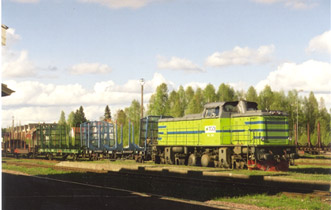
A TGOJ T43 resting for the weekend in Orsa, August 2001. See more in Ollies trainstuff!, all colorphotos by Ollie Ahokas
This feature is somewhat different, compared with the other sites I have discussed earlier. First I discuss a line that is too long to model completely by anyone, but never the less you could settle for a small portion of the of this interesting line, built for the brighter future for the citizens of the in lands of Sweden.
Inlandsbanan. (The Inland Line)
Brief history.

The Inland line was a brainstorm of the belief in progress of the 1880.ies. The railroad through the inlands of Sweden would industrialize the communities and develop these. The other main interest was the national defence; by the means of the railroad troops could be moved from the south to the new fort of Boden.
The discussions of the Inland line started 1897, when the ore line in the north was to expand to the Norwegian coast. The new railroad line was discussed and investigated to 1903, when an expedition was sent to survey the suitable line. The expedition was divided north of the river Skellefte Älven and one of the survey teams followed the eventual line. The government started to take interest in the matter and presented a proposal to the riksdagen (parliament) in 1904. A planed line across the country between Orsa and Stöa in Norway was postponed due the growing tension between Sweden and Norway, and the Inland line was an excellent excuse for this postponement.
When the union of Sweden and Norway ceased in 1905, the importance of the Inland line increased, and became a national demonstration of strength aiming to able to use ice free port in Narvik. The railroad administration declared the standards of the railroad, a maximum grade of 1 per cent and minimum of radius of the mainline 400 meters. But soon afterwards the standards were lowered and the surveys were yet to be completed.
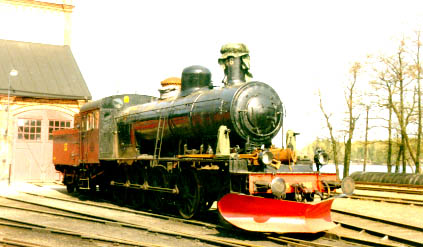
A new type of engines were constructed for the Inlandline type E, many of these 0-8-0 engines were later rebuilt to 2-8-0.s and classified as E2, like this preserved engine in Nora.
The channel of Trollhättan was nationalized by the state in 1904, five years later the parliament voted for a expansion and to dredge for to use larger vessels, This was the end of the Inland lines southernmost line from Kristinehamn to Uddevalla, and the new situation for the line clarified in the branch line commission of 1907.
The line was now to be added with a number of branch lines to the Norwegian boarder. The private line between Orsa and Sweg was completed in 1909 and now there was a direct railroad between Sweg and the Lake Vänern, the line was purchased by the government and upgraded for the future traffic. The construction of the northern part of the lines started by an accident, when the ore line was electrified a spur was constructed from Gällivare to the to the construction site of the waterpower plant of Porjus, which would provide the current for the ore line. The spur was useable temporarily 1910. The location of the line between Brunflo-Östersund was decided, much up on fear of the influence from Norway along the western part of the lake Storsjön. 1907 the location of the stretch Östersund - Ulriksfors - Strömsund was decided, and finished 1912 as the first link of the Inland line.
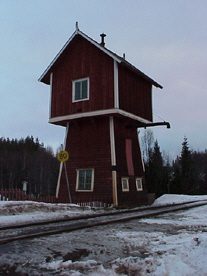
A watertank from the Inlandline. Most of the watertanks on the line were covered to protect from the cold weather during the winter.
When the construction team had arrived to the shore of the River Ångermanälven and Meselefors, the work had begun on the upgrade of the southern part of the line between Sweg and Brunflo. The both work teams met in Ytterhogdal in 1921 and a year later line was ready for the traffic. The southern line between Kristinehamn and Sweg, was now nationalized and the link Brunflo - Sweg completed. To compensate for the cancelled western route a branch line to Hede was constructed between 1917 and 1924. Now was Gällivare decided to be the northern end of the line and the temporary line to be upgraded to the standards of the new Inland line. From the shores of the Ångermanälven the workers preceded further up north, crossing three more mountain rivers. The excavations were speeded up by introduction of excavators, and the workforce arrived to Storuman in 1923 and to Sorsele in 1929. But the expenses rose during the 1.st World war and the following years and the work slowed down due lack of labour. Not until 1939 the complete line was opened for service.
But the source for the revenue was overestimated from the start, and further declining because of construction of in most cases by high ways right next tot he right of ways. The Swedish State Railways abandoned the line Kristinehamn - Mora in the 1960.ies and the traffic is now mostly using the highway 45, which is upgraded. But the rails are not removed and can be used by handcars, which can be hired in Vika southwest of Mora. The State Railways could be also blamed for the declining traffic, to the nineties the Inland line was missing in their national timetables while company still hauled passenger trains. Since the early sixties diesel engines and railcars replaced steam on passenger and freight runs. But the tourists had discovered the line through the wilderness and during the summer the number of the passengers rose in the newly built railcars.
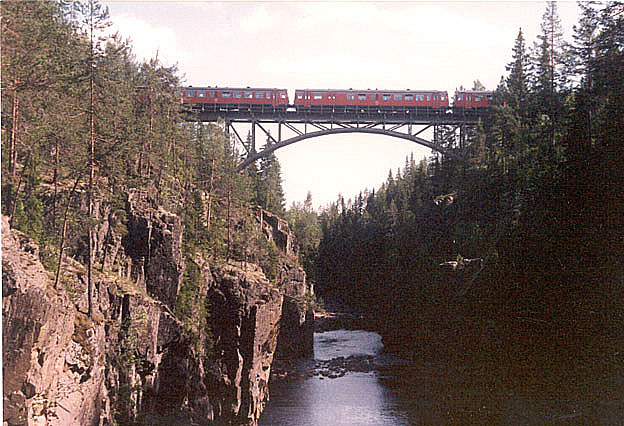
12 kilometers north of Orsa, is one of the most favous sites, Storstupet. Here during the last summers of national railservice, a Y1/YF1 train stops to let tourist take photos of this famous gorge.
The State Railway wanted to abandon the line, but the line was handed over to the communities along the line. They formed a new company, The Inlandsbanan AB (IBAB) and some motive power was handed over to the new company along some passenger cars and railcars. Additional second hand motive power was purchased from Denmark. Additional companies were formed to haul freight on the line. These are Inlandsgods and Orsatåg, the latter merged in to Inlandsgods in 2001. The old lighter rails were replaced by heavier rail in the mid 1990.ies to handle heavier trains. Timber, wood chips and peal briquettes from the area to the power plants and the paper industry located south of the line dominate the freight. In 1999 Orsatåg started to haul limestone from Kallholn and the carloads are expected to increase. The Swedish Rail System handles the maintenance of the line. In 2001 The Orsatåg merged into the Inlandsgods, which serves that line periodically today. The Y1-class railcars were replaced on tourist trains by engine-operated trains with a cafe-car and a pair of leased SJ B5 cars in summer of 2002.
The line today.
Are interested in unit-train modeling but can not deside on road to model or just bored with uniformal consists, if you say yes, read this!
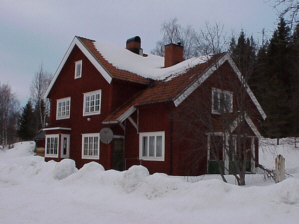
This long railway is somewhat of Trans Siberian Railroad of Sweden. On the southern part between Sweg and Mora which I am concentrating on, service consists of a single train a day, with a unit train of peal briquettes loaded into a second-hand mostly in well used 20 foot containers placed three and three on 60 foot flatcars.
The power is very interesting indeed; consisting of second-hand TMX EMD.s from Denmark and almost whatever older leased units in various schemes of their owners. The Inlandgods, always short of power, who operates the line added more color by purchasing their first unit a TMY, and repainting it in their own white and blue scheme with red graphics. The cars on this train is also interesting mix, some are owned by the operator, repainted in rather eye-catching dark blue and almost day glow orange, some fitted with bulkheads for to be able to load pulpwood as well. Some are leased from various operators, adding even more color to the train.
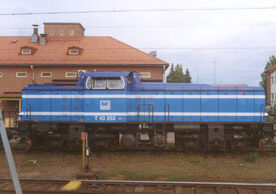
One of the colourful of Swedish diesels is the T43 class. In beginning they were painted in to a colourful blue, white and scheme and during the 70-ies repainted in blue and orange like the later T44-class.
Banverket, which is responsible for the maintenance of the national network have repainted their units in high visible yellow, with various trim in blue or grey. BK tåg, an operator of various regional lines has repainted their units in blue. There is one of the blue units leased temporarily in to container train service.
Sometimes short trains with pulp is hauled on separate consists, powered by a ex Swedish State RR T 43-class engine repainted in rather odd looking, light green and dark blue scheme of TGOJ, or in older orange and dark blue scheme. The cars in this consist are also very mixed. Inlandgods has ordered blue & orange two-unit articulated cars especially for this service, but venerable Kbs cars and older O-class are mixed with lg-class cars specially designed for hauling timber and sometimes rounded up with trucked bulkhead flats. These trains are usually 12 cars long.
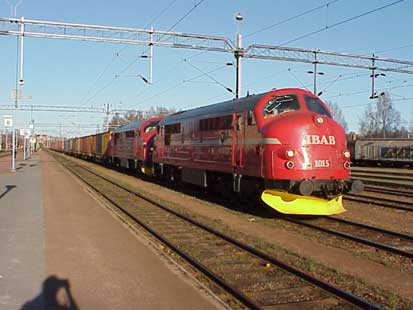
IBAB owns a quartet of ex Danish 12 cylinder based on F7.s from EMD, repainted in their livery. Half of the fleet arrives in Mora with another train of containers. Here they will have a little rest before leaving with empties back to Sweg. The loaded train will be hauled further south with a TGOJ Ma class electric.
During fall, winter and spring the unit train is hauled by two engines, usually by a pair of TMX.s, TMY.s or in mix with T43.s from various operators as the train increases in length. A typical train consists 24 flatcars with usually three containers loaded on the deck. During the winter, occasionally the temperature drops to minus 30 Celsius, a third unit is added to the power.
During the summer, the consist drops to only a handful cars and a single unit provides more than enough power and loads of pulpwood cars are added to the consist. The line has been promoted as a tourist attraction and during the summer a roundtrip service from Mora to Sweg is offered with Italian built DMU: s of Y1/YF1 class. Normally early in the season, a single or a couple of these cars provides the service, but in July the train increases in consist to 4 cars occasionally, though 3 cars is more normal. The cars are owned by IBAB, a few have repainted to promote the communities along the line, but the rather poor shape of the cars has resulted in leasing additional cars from different operators as well, so it is a norm to see this train consisting cars in various paint schemes and graphics
Sometimes, at least once or twice a year the line sees a passenger special, a shiny TMX with handful former SJ B3-class cars and a heating car repainted in IBAB.s wine red and silver scheme for officials and to impress VIP-guests. To add more interest once or twice a steam special is run on the line with a 2-8-0 E2 class engine and scrambled passenger cars from preserved railroads or clubs from the area.
After the snow thaws, the line sees various maintenance trains, old cars of various O-classes hauls with whatever power available replacement ties from Orsa and returning with loads of old ties, Orsa, which is the MoW hub in the southern portion on the line houses a various equipment for these tasks.
Short summery of Swedish railroad history.
The first engines used were on small railroads serving local industries but during the 1850.es construction of national railroads began in grand scale. It was decided that the lines considered as of national interest, would be operated by the state. Various local interests built a number of connecting lines. These common carriers varied in gauge all from 600mm to standard gauge. Many of them developed own designs independed from anything else than their needs and budget. These lines were nationalized during the forties. The very varied roster needed more standard power. For this reason a series of 2-8-0 narrow-gauge engines of Gp/Gt classes and the last standard gauge steamers of 4-8-0 E10 and the S1, very last of Swedish 2-6-4T ended the steam era. The last steam was out in 1968. In the fifties varied diesels started to replace steam. But the serious "steam killers" were the T 43-class from the early fifties used mainly for freights, and the streamlined railcars of various Y6-classes.
The national system Statens Järnvägar, took over the operation on the famous Iron Ore line Luleå-Kiruna-Narvik, and the line was converted into electric railway during WWI, and the lower operating cost and increased capacity influenced to the convert in to juice, the first standard electric was 1-C-1 D-class that in various configurations was built from 1928 to the end of WWII. During the fifties a modernized version was constructed called Da, from which the new single cabbed iron ore line power was constructed, called Dm, a second series included an additional cabless middle units and these engines are called Dm3 . But more modern versions of electrics showed up in the fifties, like the six-axel Ma and the streamline light express engines of Ra class. The latter lead to a small series of Rb-class engines in the sixties as prototype to the various Rc classes used in all kinds of trains today. During the nineties, a need of even faster services on IC-runs developed to introduction of X2000 service on the runs on the trunk lines and by Regina-trains on regional runs.